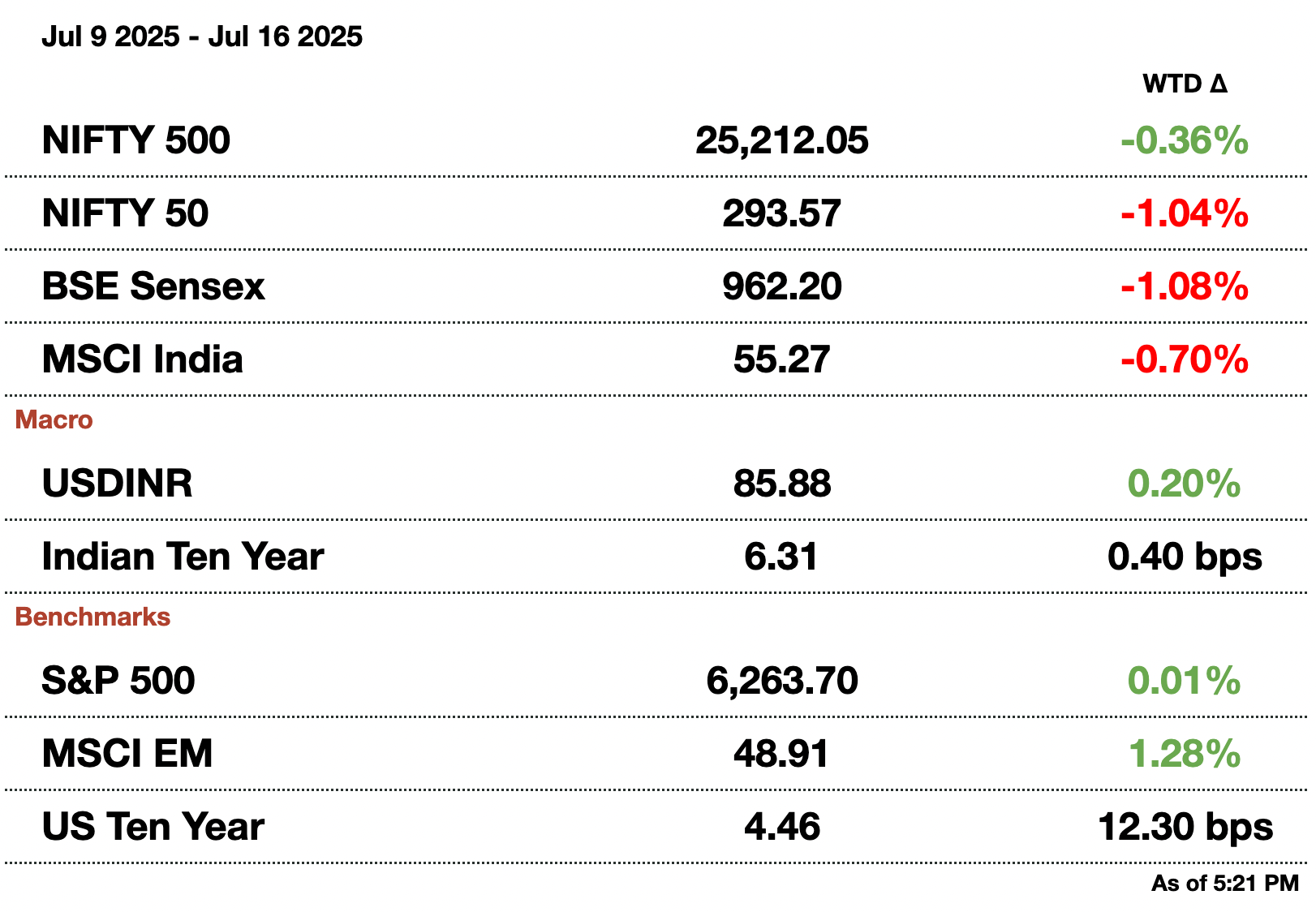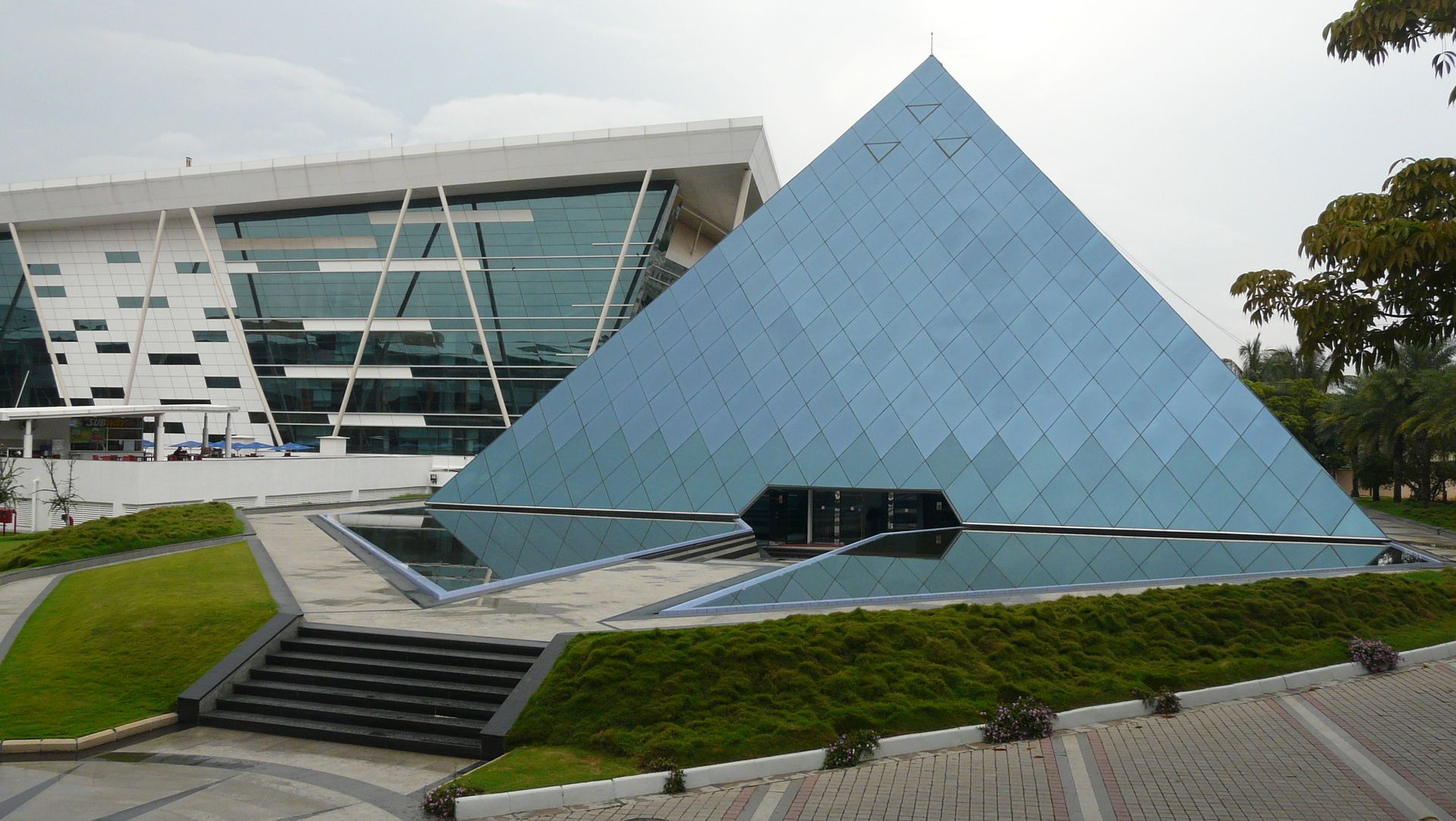- Samosa Capital
- Posts
- 📰We need to talk about Indonesia | Daily India Briefing
📰We need to talk about Indonesia | Daily India Briefing
Three stories on Indian markets that you can't miss.


What Does Trump’s Indonesia Trade Deal Mean for India? India’s $283 billion IT services industry is bracing for a prolonged period of demand uncertainty. India’s big investors get new hedge-fund-like options.
If you have any questions about India, fill out this form or reach out to Shreyas at [email protected]



Macro
India’s volatility index has fallen to its lowest since April 2024, as investors grow confident that Trump’s tariff threats are more rhetorical than real. Hopes of RBI rate cuts are also boosting sentiment, even as stretched stock valuations raise concerns about returns.
India’s benchmark indices ended flat on Wednesday, as gains in public sector banks like SBI offset losses in metal stocks triggered by a stronger dollar. Analysts expect markets to stay range-bound amid U.S. inflation concerns and mixed earnings signals.
India's imports of Russian oil rose 1 percent in the first half of 2025 to about 1.75 million barrels per day, with Reliance Industries and Nayara Energy accounting for nearly half the purchases. Private refiners relied on term deals, while state-run firms continued spot buying.
India's gold imports fell 40 percent year-on-year in June to a two-year low of 21 tons, as record-high prices hurt demand. Imports in the first half of 2025 dropped 30 percent, with retail buyers pulling back amid a 27 percent surge in gold prices this year.
Equities
Vedanta’s Zambian copper unit, Konkola Copper Mines, will fully refurbish its smelter to boost output as part of a $1.2 billion (₹103.1 billion) investment plan after regaining control of the asset last year. The upgrade aims to lift production to 300,000 tons by the next decade, up from under 10 percent of that now.
Schneider Electric is in talks to buy Temasek’s 35 percent stake in their Indian joint venture for about $1 billion (₹85.9 billion), potentially valuing the unit at $5 billion (₹429.5 billion). The deal would give Schneider full control as India’s M&A activity accelerates.
Angel One's Q1 profit plunged 61 percent as tighter SEBI rules on derivatives trading reduced retail activity and daily turnover. Revenue also fell nearly 19 percent, with client acquisition dropping 40 percent year-on-year.
State Bank of India is launching a $2.9 billion (₹249.1 billion) share sale to institutional investors, India’s largest ever, to strengthen its capital base and support loan growth. This marks SBI’s first equity market tap since 2017.
Alts
Jio BlackRock has received approval from India’s markets regulator to launch five passive index funds tracking major equity and bond indices. The joint venture plans to roll out nearly a dozen funds by year-end.
India's Embassy Office Parks REIT plans to raise ₹20 billion ($233 million) via five-year bonds by the end of July. The AAA-rated notes are expected to attract strong interest from mutual funds and insurers
Policy
NATO chief Mark Rutte warned that India, China, and Brazil could face U.S. secondary sanctions if they continue business with Russia and fail to push Putin toward peace talks with Ukraine. The warning follows President Trump’s threat of 100 percent tariffs and legislation proposed by U.S. senators targeting nations supporting Russia’s war efforts.
India's market regulator SEBI has proposed requiring asset managers to use domestic spot prices from commodity exchanges to value gold and silver, aiming to boost transparency and consistency. The move comes amid rising investor interest in safe-haven assets, with gold ETF inflows hitting a five-month high in June.

1. What does Trump’s Indonesia Trade Deal Mean for India

Jakarta, Indonesia
India’s push to secure a competitive trade deal with the US is under fresh scrutiny after President Trump’s new pact with Indonesia set a precedent for regional tariff rates. Under the deal announced this week, the US will impose a 19 percent tariff on Indonesian goods, down from a threatened 32 percent, while securing significant purchase commitments of US energy, agriculture, and Boeing aircraft.
For India, now racing to finalize its own deal before the August 1 tariff deadline, the benchmark set with Indonesia and Vietnam, both facing tariffs around 19–20 percent, raises the stakes. New Delhi is lobbying for a lower rate to preserve its export edge in sectors like electronics, apparel, and auto parts. Officials close to the talks say India’s negotiating team aims for tariffs below 10 percent, banking on its position as a less likely transshipment hub compared to Vietnam and its strategic importance as a market for US goods.
State Bank of India’s chief economist Soumya Kanti Ghosh notes India may offer greater access for US industrial goods while protecting politically sensitive sectors like agriculture. For now, India’s trade gap has narrowed, and exports have held up despite global turbulence, but higher tariffs could undercut this fragile momentum.
How India positions itself in the next two weeks will be critical. Securing a deal better than its Southeast Asian peers could help stabilize the rupee, keep export growth on track, and signal New Delhi’s growing leverage in an increasingly protectionist global trade environment.
2. India’s IT Sector Faces A Clouded Outlook

IT consulting firm Infosys headquarters in Banglore, India
India’s $283 billion (₹24.3 trillion) IT services industry is bracing for a prolonged period of demand uncertainty as fresh tariff risks from the US and global geopolitical tensions weigh on client confidence. Speaking at Wipro’s annual shareholder meeting, Executive Chairman Rishad Premji acknowledged that while conditions haven’t worsened dramatically, the environment remains fragile with no clear signs of a strong rebound.
The US, India’s largest export market for IT services, is at the center of the sector’s worries. President Trump’s evolving tariff policy, including recent deals with Indonesia and Vietnam that set higher baseline import duties, has rattled Indian tech executives. A recent survey showed that nearly two in five tech clients in the US have deferred discretionary IT projects.
So far, the June quarter earnings reflect this caution: Tata Consultancy Services, India’s largest IT company, missed revenue forecasts as clients delayed project starts, citing tariff and cost concerns. Peer HCLTech also posted weaker-than-expected profits and trimmed its margin guidance for FY26.
Premji noted that clients are prioritizing cost-saving and efficiency-focused tech spending over new digital initiatives. While there are some early signs of revival in discretionary spending, the outlook remains murky as decision-making cycles lengthen.
With India’s IT exports accounting for nearly 8 percent of GDP, sustained weakness would pose wider macro risks, including a hit to services trade surplus, hiring, and urban consumption. For now, the sector, a vital dollar earner, must navigate the double squeeze of cautious clients and policy unpredictability in its top market.
3. India’s Wealthier Investors to Get New Hedge-Fund-Like Options

SEBI headquarters
India’s asset management industry is gearing up for a structural shift as top mutual funds and global players line up new long-short equity funds targeting the country’s wealthier investors. At least ten Indian and foreign firms, including ICICI Prudential, SBI, and Mirae Asset, have received or are awaiting regulatory approval to launch these higher-risk products under a new “Specialised Investment Fund” (SIF) category.
Under SEBI’s new rules, these funds can take both long and short positions in stocks, similar to hedge funds, but with a minimum investment size of $11,600 (₹1 million). The move comes as India’s market regulator seeks to deepen institutional participation in the derivatives market, where domestic funds make up barely 0.2 percent of total trading volumes, according to NSE data.
Industry executives say these SIFs could channel more sophisticated strategies into India’s equity and derivatives markets, potentially stabilising volumes and adding depth. Hedge funds and quant firms like AlphaGrep and Abakkus are also seeking mutual fund licences to roll out similar offerings.
While India’s $866 billion (₹74.4 trillion) mutual fund industry has boomed on the back of retail SIP inflows, the SIF category represents a shift towards alternative products for high-net-worth individuals, aligning with global trends as wealthy investors demand more flexibility and uncorrelated returns.
How these strategies perform will depend on their scale and how they complement India’s fast-evolving capital market ecosystem, especially amid recent volatility in options trading. The success of this segment could be a crucial test for India’s ambitions to grow its institutional investor base in equities and derivatives alike.
How would you rate today's daily briefing? |
See you tomorrow.
Written by Eshaan Chanda & Yash Tibrewal. Edited by Shreyas Sinha.
Sponsor the next newsletter to reach tens of thousands of U.S.-based business-savvy professionals. Reach out to [email protected].
Could your business use expert insights to power growth in India? Reach out to [email protected] for a free introductory call.
Disclaimer: This is not financial advice or recommendation for any investment. The Content is for informational purposes only, you should not construe any such information or other material as legal, tax, investment, financial, or other advice.